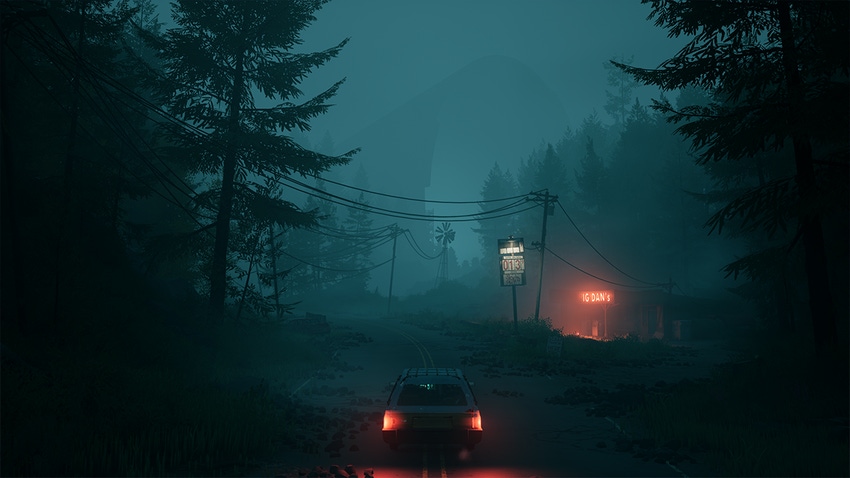How Pacific Drive uses a diegetic UI to help players fall in love (with a car)
"You take care of the car, and it's going to take care of you."

Pacific Drive is what you might get if Nicolas Winding Refn stepped in to direct an episode of Stranger Things. The atmospheric run-based survival adventure hinges on the bond between players and their car, except instead of outrunning their past, they'll be dodging supernatural anomalies as they launch expeditions into the Olympic Exclusion Zone in a bid to understand and escape the surreal calamity reshaping the world.
Between excursions, which see players scavenging for resources and learning more about the experimental leftovers scattered by the mysterious ARDA organization, you'll likely find them tinkering with their trusty station wagon in the safety of an oil-stained garage. It's here that our recent Gamescom 2023 demo began, and I immediately set about remodeling my four-wheeled companion, manually prying off paneling and swapping out tires to prepare for that next death-defying crusade.
What struck me about this portion of the demo was how developer Ironwood Studios has fully committed to the bit. To save resources, some studios might've had players upgrade and customize their ride in-menu, but not here. Working on your car is a tactile, intentional experience that's surprisingly therapeutic, providing a welcome contrast to the crackling tension that underlines each run.
Drive to survive
During our demo, game director Seth Rosen said that when they joined the project, upgrading the car and restocking was a menu-driven experience, but the team quickly set about changing that in order to foster a relationship between players and their vehicle.
"The car is kind of like a shield. It's very much a symbiotic relationship. You take care of the car, and it's going to take care of you," said Rosen, who added that he wanted the upgrade system to feel sensory but "snappy." Out in the wilderness, the car becomes a player's first line of defense, soaking up damage above a certain threshold to help keep them alive, which means keeping your motor in tip-top shape becomes paramount.
Ironwood also sought to imbue the truck with a sense of individuality by implementing a quirk system that'll see it develop something of a persona over time. "We want the relationship players have with their car to be really strong by the end of the game, so have a quirk system," continued Rosen. "Some of those quirks are neutral and harmless, some of them are actually quite bad, and some can actually be helpful. And we have a keyword diagnosis UI, similar to Return of the Obra Dinn, where you have to figure out what's going on with your car if you want to fix it."
There's a physicality and weight to almost every interaction in Pacific Drive that Rosen said was driven by a desire to make the in-game UI as diegetic as possible. "We tried to place as much as we could physically into the world, because that helps sell the relationship with the car, but also the sense that this is a real place that's threatening," he added.
It's design choice that places a real burden of responsibility on players. During my first run, I accidentally swerved into a tornado-like anomaly that essentially performed a vehicular body slam on my beloved motor, which crashed back down to earth with an almighty crunch. Ironwood's decision to focus on tangible ramifications means those mistakes will leave a mark, and remedying them will sometimes require outside-the-box solutions.
"In order to make all of this locational damage stuff on the car work, we have an immersive sim-style damage system. That system, and all of the things it enables, was lurking underneath the skin of the game, but for a long time, our in-game tools were restricted by certain parameters," he said. "For example, players might've only been able to use the scrapper [used to break down resources] on specific items. We've recently opened that up so that players can use tools everywhere, and that enables really inventive problem-solving and shenanigans."
The resulting systems facilitate moments that feel both more intuitive and emergent while hopefully curbing the number of times players will find themselves asking 'why can't I do this?'–which, in Rosen's own words, would be "bad."
Rosen said it also solved some of the resource management problems Ironwood had encountered by allowing players to improvise and overcome. "There's a tool called the scrapper that's the best way to obtain the basic materials, but if your scrapper runs out of juice and you still have a hammer to-hand, you can use that in a pinch to break apart and collect materials," he explained, indicating that survival might sometimes require players to adopt an 'any solution will do' approach.
Right now, Pacific Drive appears to have all the ingredients for success. Over the course of our 30-minute demo, Ironwood's commitment to crafting a deep, systems-rich experience was apparent, but beyond that, it's also just one hell of a vibe. It'll be interesting to see how it shapes up when it rolls out of the showroom in 2024.
For more on Pacific Drive, click here to learn more about the secret sauce behind the game's spooky vibes, or read about the survival roguelike design fundamentals purring away under the hood.
Read more about:
FeaturesAbout the Author(s)
You May Also Like













